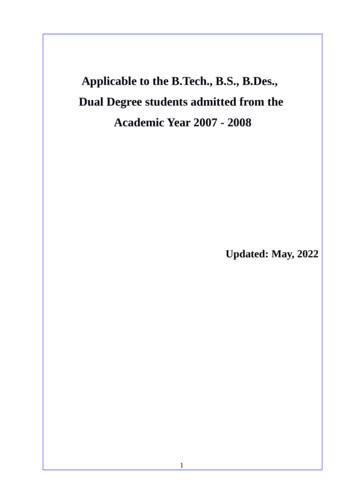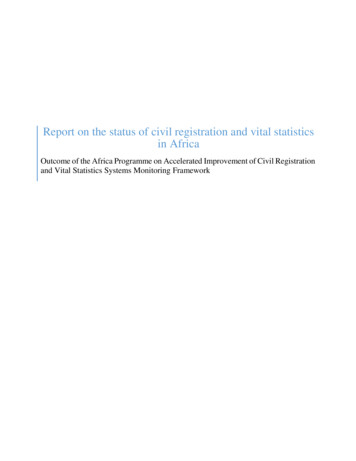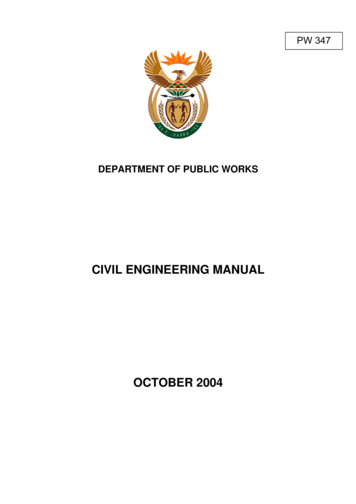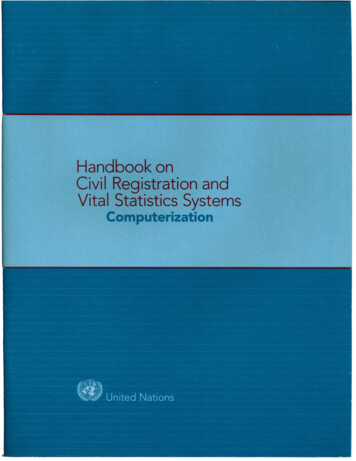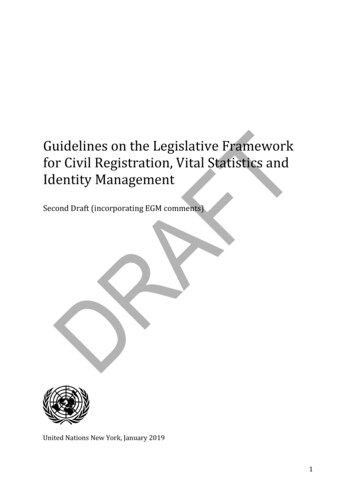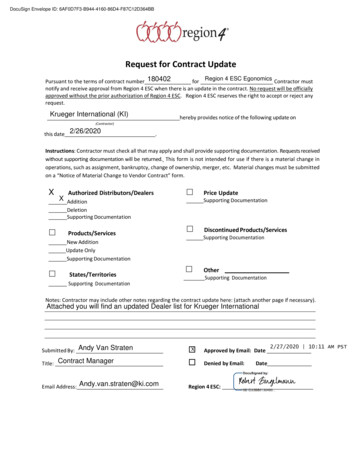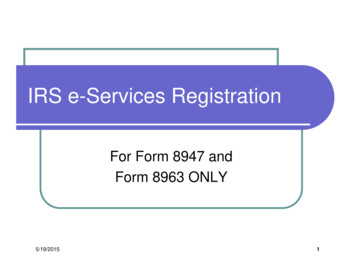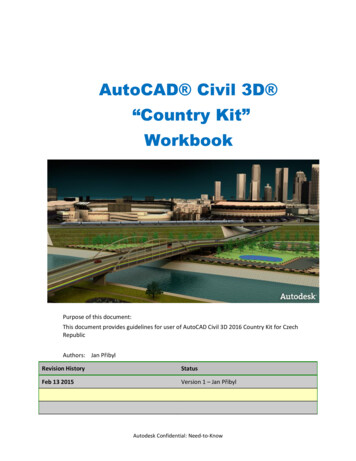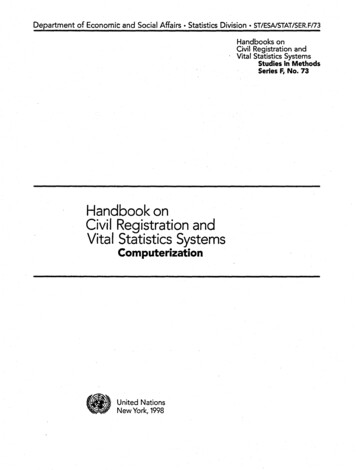
Transcription
Departmentof Economicand Social AffairslStatistics Division. ST/ESA/STAT/SER.F/73Handbooks onCivil Registration and. Vital Statistics SystemsStudies in MethodsSeries F, No. 73Handbook onCivil Registration andVital Statistics SystemsComputerizationUnited NationsNew York, 1998
NOTEThe designations employed and the presentation of the material in this publication do not imply the expression of any opinion whatsoever on the part of the Secretariat of the United Nations concerning the legal status of any country, territory, city or areaor of its authorities, or concerning the delimitation of its frontiers or 403-1United Nations 1998All rights reserved
CONTENT!3ParagraphsPreface.IntroductionI.Framework of civil registration and vital statistics systkms .A. Definition of civil registration .1. Uses of vital records. .2. Effect of computerlzation .B. Definition of a civil registration system and vital statistics system. .: .1. Civil registration system. .2. Vital statistics system .C. Interface between civil registration and vital statistics .1. Completeness and timeliness .2. Codification .3. Extractions from administrative registers .D. Implementation of computerized civil registration and vital statistics systemsII.Overview of computerhation and automation stages in civil registrationand vital statistics systems in various countries .A. Introduction .B. Some first choices. .1. Automated index. .2. Microfilm .3. Optical disk technology .4. Numbering systems .5. Some examples from the United States of America. .6. Implications of first choices .C. Available software .1. Electronic birth record. .2. Electronic death record .D. Phased approach to the computerization of civil registration andvital statistics systems. .III.Overview of major decisions and problem areas of computerization. . . . .A. Introduction. . . . . . . . . . . . . . . . . . . . . . . . . . . . . . . . . .B. Major decisions . . . . . . . . . . . . . . . . . . . . . . . . . . . . . . . .1. Defming the framework of civil registration and vital statistics systems2. Defining the unique key to be used in the civil registration system. . 41-4748-4950-5 152-5960-737475-8476-8 293-951313131313
Paragraphs3.4.5.6.7.8.9.Defining the objectives and.purposes of computerization. .Establishing the organization that will handle computerization. .Deciding on overall development strategy and operational strategy . .Hardware con@uration and procurement. .Inviting external contracts .Choosing a conversionlinitialization strategy .System functionality. .Page96-9798-100101-104105106107- 1081091414141415151-SPurpose of computerization .A. Introduction. .; .3. Improvement of civil registration data .C. Coordination and integration .D. Unique registration number. .1. Person-identification number, using specific personal information. .2. Person identification number, using specific personal anddemographic information .E. Other benefits .1. Automated issuance of certificate copies .2. Security of computerized civi1 registration data. .3. Misuse by administrators of the civil registration/vital. statistics register4. Operator accessrestriction. .5. Introducing the population register .F. Coordination and integration of vital statistics data .1lo-151110-112113- 118119- 120121- 4s146147-15 11919191919202020V.Project phases. .A. Introduction .B. Advance planning: feasibility study .1. Systems in place .2. Framework of the computerized system. .3. Organization and management .4. Legislation. .5. Mechanics of the future system .6. Master pIan for implementation .C. Bid and contract. .D. System evaluation and acquisition .1. Acceptance tests .2. Contract .3. System development. .E. Next phases .152-182154- 156157-171158-160161-165166167-168169170- 171172-174175-18 1175-176177-178179- 181182212121212222222323232323232424VI.Organizing computerization .A. Introduction .383-232183-187.252sIV.; .iv
199-200201202203204-205206207-2 223224-230225-22622722822923023 03131313131VII.233-254Initializing the civil registration register .236-239A. Why. initialize the civil registration register? .240-249B. How to initialize the civil registration register .24 l-2451. Conversion of data already existing on electronic media .2. Manual entry of information from existing vital records and documents 246-2473. Collection of information within the population and manual entering . . 248-249250-252C. Time-frame-from initiahzation to operation .253-254D. Archiving paper-based forms .3232333333343435VIII.System functionality aud requirements. .A. Software requirements, functionality and design. .1. Events and tabulations. .255-293255-276257363636Organizationai structures of civil registration .1. Principal centraked system. .2. Other centraked systems .3. Decentralized systems .4. Local registration authorities .C. Overall organizational structures .1. Main active partners. .2. Civil registration agency. .3. Local CiviI registries. .4. Basic authorities. .: .5. Individual residents .6. Other active partners. .D. Recommendations concerning the general structure of civil registration . .1. Civil registration agency. .2. Local civil registries .3. Basic authorities .E. Organizational structures during advance planning and system development1. Overall structure. .2. Steering group .3. Reference group .4. Project organization .5. Basic organization .F. Organization after system implementation .1. Computer centre .2. Reference group .3. Legalsection. .4. Utiliiation section .5. Security section .G. Organizational structures of vital statistics .3.V25
Paragraph2. Logical data entities and their data items .3. On-line functions and functionality .4. Validations, business rules and procedures .5. Civil registration and vital statistics interface and other utilities .B. Hardware requirements .C. Security system requirements. .1. Physical damage. .:. .2. war .3. Misuse of information4. Misuse by administrators of the civil registration and vital statisticsregister .5. Operator accessrestriction. .i’ .D. Functionality of the vital statistics system .1. Error search programs2. Storage of data. .3. Tools for analysis of data .E. 939Definition of civil events .Definition of standard population event registration .Definition of recommended vital statistics tabulations. .Sampie table’of contents for civil registration feasibility study .Logical entities and their data items in the civil registration system .Decision process for choice of initialization method. .Case study: computerization of the civil status and vital statistics systemsof Seychelles and their integration with the National Population DatabaseAppendix I.Structure of the National Population Database .Appendex II. National Population Database user guide .Appendix III. List of data fields in the National .Population Database. .Appendix IV. Seychelles national identity card: application form(new/renewal) .Case study: computerization of the civil registration system-in Scotland . .404142444548References . . . . . . . . . . . . . . . . . . . . . . . . . . . . . . . . . . . . . . . .67VIII.vi495354585960
PREFACEand the UNFPA country support teams. Financialsupport has mainly beetrprovided by UNFPA.A vital part of the International Programmewas the convening of five workshops between 199 1and 1995, with the participation of senior civil registration experts and statisticians from specificcountries and regions in the world. The workshopsserved as a forum for exchange of information andexperience between member States, and adoptedseveral resolutions to support the improvement ofcivil registration and vital statistics systems in eachregion of the world, which-are included in the reports of the workshops.’In continuation of the International Programme and with financial support from UNFPA,the United Nations Statistics Division has prepareda series of five subject specific handbooks to assistcountries in improving their civil registration andvital statistics systems, as-follows:(a) Handbook on Civil Registration and Vital Statistics Systems: Management, Operation andMaintenance;.(b) Handbook on Civil Registration and Vital Statistics Systems: Preparation of a LegalFramework;(c) Handbook on Civil Registration and Vital Statistics Systems: Developing Information,Communication and Education;(d) Handbook on Civil Registration and Vital Statistics Systems:Policies and Protocols for theRelease and Archiving of Individual Records;(e) The present Handbook.,The. present Handbook on Civil Registrationand Vital Statistics Systems: Computerization provides uidance to decision makers and the relevantauthorities of countries for the development and implementation of administrative electronic dataprocessing systems for civil registration and vitalstatistics systems; The Handbook focuses on guiding the advance process and analysis leading tosuch computerization, and offers a number of options for countriesto consider, including model organization structures for planning; implementingand maintaining the computerization. It examinesthe framework, goals and purposes of the computerization of civil registration, looksat the interfacebetween civil re gistration,the vital statistics systemand other governmental agencies, and enumeratessome of the major decisions and problem areas thatcanbe anticipated.in a move to computerization. Itis the experience of several countries that the success of computerization depends on organization,advance planning and clear decisions and goals farmore than on technical matters. Illustrations fromthe, systemsof a number of countries are used in theanalysis. The present Handbook gives priority to asystem concept ,according to which the.registrationof vital events takes.place in the civil registrationsystem, which byextraction:fromthe database delivers the required data to the vital statistics systemfor statistical treatment. The Handbook has beenprepared as part of the International Programme forAccelerating the Improvement of Civil Registrationand Vital StatisticsSystems.The International Programme was designedby the United Nations Statistics Division, theUnited Nations Population Fund (UNFPA), theWorld Health Organization and the InternationalInstitute for Vital -Registration and Statistics. It wasadopted by the Statistical Commission at itstwenty-fifth and twentylsixth sessions, in 1989 and1991. The International Programme encouragescountries to undertake long-term self-sustainingprogrammes of reforms to strengthen their civil registration and vital statistics systems, It is being implemented in phases by the United NationsStatistics Division, focal point for the Programme,with the cooperation of the regional commissions‘See report of a Latin American workshop on strategies for accelerating the improvement of civil registration and vital statistics systems,Buenos Aires, 2-6 December 1991. pp. 18 to 23; report of a westernAsia workshop on strategies foraccelet%ing the improvement of civilregistration and vital statistics systems, Damascus, 20-24 June 1993;report of an East and South Asia workshop on strategies for accelerating the improvement of civil registration and vital statistics systems,Beijing, 29 November - 3 December 1993; report on an African workshop for English-speaking countries on strategies for accelerating theimprovement of civil registration and vital statistics systems, AddisAbaba 5-9 December 1994; report of an African workshop forFrench-speaking countries on strategies for accelerating the impmvement of civil registration and vital statistics systems, Rabat. 4-8December 1995.Vii
Readers are encouraged to consult all fiveHandbook, including the present Handbook and itsannexes and references.The present Handbook describes in its eightchapters the activities that countries should carryout to tailor their own civil registration system totheir specific historical, demographic, legal and administrative conditions at the time of computerization. of such a complex system. Only in this waywill countries benefit fromthe investment made incomputerization.A phased approach is suggested for the computerization of civil registration and vital statisticssystems. One suggested scenario for phased computerization would tie each phase to specific vitaland civil status event& beginning with basic vitalevents and-if countries so wish and resourcespermit-culminatingin 8 population registrationsystem. The importanceof initializing the computerized system with population status data is a keyelement of the present Handbcrok. It is anticipatedthat the concepts presented in the text and the annexes will be helpful in easing the process of computerization of the civil registration system. TheHandbook should inspire the responsible authorities to analyse the administration in place and carryout the computerization based on the actual statusof each specific country.The present Handbook looks at some of theeffects that computerization will have on civil regis.tmtion, including the possibility of developing aunique personal identification number as the key tothe system. The computerization of civil registration will-require uniquely identifying each individual and ensuring that each and every vital event isrecorded once and only once, in both the civil registration and vital statistics systems.It recommends,for example, that countries follow a process thatleads to a unique numbering systemto track the records of its vital events. However, a recommendation on the appointment of the unique. personalidentification number as the national identificationnumber for each individual in the country is beyondthe scope of the present Handbook.Some oftie examples used in the Handbookare taken from countries where population registersare closely linked with the civil registration system.In some cases,the.numbering system forcivil registration is closely tied to the personal identificatronnumber used to update information on individualsin the population register. As with cases in whichthe civilregistration-system is not tied to-the popuration register, the examples-provideWe meant tobe illustrative of the computerization process ratherthan to recommend a particular course of action.The Hun&auk concludes by considering some ofthe security measures needed by the two systemstoensure confidentiality and the preservation of’data.It also outlines the requirements of the hardwareand software needed to operate and maintain thesystems.It should be realized that a computerizedcivil registration system is not mereiy. an elec-ironicregistration of chronological series of vital eventsand their retrieval. Indeed, computerization of thecivil registration system means much more thanmerely doing electronically what is being donemanually by the present structure, or else it wouldnot be an important and useful.substitute for a.manual civilregistration system- Accordingly, it wouldbe a great mistake to consider the compoterizationof such complex systems as civil registration andvital statistics as a mere technical matter that can beachieved by any country.The target groups. of the present Handbookare made up, of countries with: (a) very differenttechnological practice, experience and skilIs; (b)very different legal and administrative practices;and (c) different financial meansfor accomplishinga computerization project. In addition, targetgroups range from countries with only manual registration procedures to countries. that have initiatedcomputerization partly or to K.greatextent. Becauseof that diversity of scenarios at the. country lever,the Handbook avoids step-bj? stepinstructions for aparticular computerized civil: registration system;the usefulness of the.Handbook would be very limited if only one definite concept and one set:of procedures to be followed were given.The present Handbook was prepared by theUnited Nations Statistics Division, with the assistance of,CSC DataCentralenof Denmark, a consultant for this purpose. A final review and revision ofthe Handbook from a technical and editorial pointof view was conducted by Mr. Joseph Carney, Director of the Division of%3ahh Statistics and vitaiRecords, Co1orado Department of. Public tiealthand Environment. Expert advice in,the preparationof the Hundbouk is gratefully- acknowledged’fromMr. Bent Dali, Project Manager, CSC DataCentralen; Mrs. Jane-Bloch, CS’O DataOentralen; andMr. Jose h Carney, United States of America. TheUnited if ations is also grateful to Mr. David B. L.Brownlee of the General Reglsfer Office for Scotland, and Mr. G. P. Ah-Shung,. Electoral Commissioner and Chief Officer of the Civil Status,.Government of Seychelles, for their contributions.vlll
with case studies to the present H”dirrlbook. The following bodies and individuals arealso acknowledgedfor their commments on the manuscript: Ms. Pamela Akisson, Director of the Bureau of ProductionSystemsand Management, New York State Department of Health; Ms. Dorothy S. Harshbarger, StateRegistrar and Director, Center for Health Statistics,Alabama Department of Public Health; Health Statistics and Vital Records Division, Colorado Department of Health and Enviroment; Mr. VitoLogrillo, Director, School of PubIic Health, NewYork State University; Mr. Duy Man Vu, ProjectCoordinator, Computer Software in Support forPopulation Activities, United Nations Statistics Division; Mrs. Violeta Gonzales Diaz, Statistician,United Nations Statistics Division; Mr. PatrickGerland, Software Specialist, United Nations Statistics Division; Mr. Uwe Deichmann, TechnicalSpecialist, Geographic Information Systems andComputer Mapping, United Nations Statistics Division; and Mr. DjamalbEddine Benzine, United Nations Statistics Division.ix
INTRODUCTION1. The present Handbook on Civil Registration and Vifal Sfatistics Systems: Computerizationis divided into eight chapters, as described below.goal. A project to computerize the civil registrationindexes in Scotland is used throughout the chapterto illustrate the phases.2. Chapter I outlines the key @u-posesandgoals of civil registrzion and vital statistics systems. It looks at somecfthe effects thatcomputerization will have on civil registration, including thepossibility ofdeveloping a uni lue@rsonal identification numberas the -key to the Qstem. The chapterthen examines- the key areas of’ interface betweenthe civil registration and vital statistics systems.With reference to implementing. the computerizedsystem, chapter I recommends a phased approach.Computerizatlon of the civil registration7.system need not be limited to doing electronicallywhat is being done manually by the present structure. Chapter VI considers the issues surroundingthe current structure of civil registration withincountries and what implications computerizationcan have on that structure. It gives specific recommendations concerning the- type of structure to beused for both the advance planning and system development phases, as well as for basic organizationafter system implementation.3. Chapter 11 provides an overview of thedifferent stages.of‘ computerizttion, and discussesthe computerisation of individual portions of thecivil registration system for countries that may notbe in a position ta @tempt full implementation. Thechapter concludes with more detailed informationconcerning the recommended phased.approach,4.Chapter IlIenumerates some of the majordecisions and problem areas anticipated in a moveto computerization. It specifically outlines ninemajor decision points that need to be anticipated,whether considering eartial or complete computerization.5. ChapterlV examinesthe purpose of computerizing the civil registration. system, includingits effect on the vital statistics system- and othergovernmental agencies. The chapter looks at theoption of using- a- personal identific ation numberand considers. the- benefits to be reaped from computerization of&ii registration.6. Chapter V lists the phases to be includedin a computerizafion project, whether the countryhas a full %le- project or a partial project as itsThe principal focus of chapter VII is the8.transition from the civil registration system beforecomputerization to the civil registration system afterimplementation. It introduces the concept of “initiali&on” of the system, and outlines the proceduresnecessaryto avoid a register that divides the population into those reported end those not reported.9. The Handbook concludes by looking athardware and software requirements in relation tothe functionality that the- country. desires to obtainfrom the computerization-- of its civil registrationsystem. It considers issuessurrounding the extraction of data from the civil registration system foruse in the vital statistics system. Chapter VIll alsooutlines some of the security measures needed bythe two systems.10. Crucial to the impact of the presentHandbook are its annexes: it is recommended thatthe reader consult each carefully. Of particular siginificance are annexes VII, which contains an illustration of computerization in Seychelles, and VIII,which describes the progress of computerization inScotland in recent years.
I.FRAMEWORKOF CXVlL REGISTRATIONAND VITAL STATISTKSA,.i%23MTION2. Eflect of comptrterizationOF CJYIL REGISTRATION11. The United Nations defines civil registrationas “the continuous,permanent compulsory recording. of the occurrence and characteristics ofvital. events. and as provided through decreeofregulation, in accordancewith the legal requirement in eachcountry. Civil registration.is carriedout primarily for.the.vJueof thelegal documentsasprovided by law. However, tie usefulnessof theserecordsas,a.s.ource.ofstatisticsis becomiugincreasingly recqnized”.z There is ailso- a frameworkwithin.which civilreg@ration exists. That framework should cover all vital events occurring in allgeographic areasand all population groups in thenationalarea. Civil registration shouldinclude livebirths, deaths, foetal deaths, marriages and divorces. An ultimate goal is to also.include.annulments,judicial separations,adoptions,legitimationsand recognitions,SYSTEMS13. Computerizing civil registration willhave a number of effects. When oomputerizingcivil registration, a different: viewpoint is. t‘akern;The civiil eglstrat onsystem3X5nc.eptfocuseson theindividiral‘as the main key to thecivil events.information linking all. registrations to Ithe. individual.By establishing this linkage the:civil registrationsystem-is frorrr the ve:ry first version preparedforfuture changesancladditions. The presentchapterdescribesand recommends:aip;h.ased:systenrsf implementation. Aggregatedd’atafrom civil registration producesvital statistics for, use in populationprojections and estimates, health and. pofiulationprogrammes,14. “L’hecomputerizatiQnof&i1 registrationwill broadenthe.uses thatcan 6e madeof the civilregistration system; tinkag,e uf the civil registration systemto othercomputerized systemswill be1. Uses of vital recordscome possible. It will become;more imp-ortanttouniquelyidentify each individu&.and to.ensurethat12. Civil registration.has many q.ses. Birtheachand.every event is recorded once an8 onlyrecords provid!: individuals with. legsgl proof ofonce,inboththe-civil regisbrafisn- system-.@ndtheidentity, age Gationality andparentage:ThelrecQrdvitalstatisticssyste.m. Issuanceof a unique regiscan&o help.determinetights. o, s bene ts,trationorpersonalidentification number shouldchild custody md.tax cSeductions.A. death recordtakeplaceatthe.timeof,birthorat the initialregiscanclarify nheritauce-rights,properclaim to insurtrationofanindividual,How this.isdone will varyancebenefits and the right. of&e surviving spousefrom.systemtosystemand.fromcountry to counto remarry. Lists of deaths can be used:to purgetry.However,theappointmentof the unique pervoter registration rolls and to close,out mtirementsonalidentificationnumberasthenational identibenefits; Divorce-recordsarealso important for esficationnumberforeachindividualis a subjecttablishing the tight to remarry. Marriage anbeusedforestablishingtax ofthepresentthe right40 alimony. in the event of divorce and‘esHandbook.tablishingclaim to property in theeventsf theqartner’s death; Uses:of aggregated.data from civil15. As stated.above,,in. civil registration theregistration include, population estimates, healthuseofa. ersonal.ide tificrafion Qurb s- imporstatistics anddemographic forecasts.tant for Pinking achlld to its. e t .and orlWngtwo spouses.In vital statistics; the: ersonal%dentification number is important foridenti ingeach-individual for linking. a child to its mox ’ er at@ viceversa. Last but not Ieast;the pnique-personaLtier!ti‘SeePrin pclpfesarr4Rec ti* raVital St@tics System,statist&alpapers. Series M, No, 19, Rev.1 (u@ed Natiods publica- fication number provides the link betweenthe.civiltion;. Sales No. E.9O.XVIl. ). pm. 278.registration register,andthe vit.al:statisticsregister.2
Other numbering techniques can also be used to accomplish these tasks, as discussed in chapter II behw.B. EFINI’fIONOF A CIVIL REGISTRATIONSYSTEM AND VITAL, STATISTICSSYSTEM16. The scope and extent of civil registrationand vital statisticsoften varies from-country to country. Therefore it is important to establish aclear definition of the civil reg&ation system and the vitalstatistics systemand the interface between them.31. Chit registration system12 G&i1 registration. is primarily carried outfor the value of the legal documents. One distinguishes-a eomptnerized civil registratiun system 8sthe electronic @gistration and updating of the civilinformation liied to individuals of the country inthe events-isfhvebirth, death, marriage, divorce, foetal death, annulment, judicial separation, adoption,legitimation and recognition,(see annex I below forthe United Nationsdeftitions ofthese events).18. Civil registrazion should-not be mistakenfor population registration, which is present inmany countries. Population registration covers awider range of events, such as immigration (firsttime registration) and change of address, togetherwith some.{or all) of the events of civil registration,including change of name (see annex II below forstandard definitions of population event registration).19. A civil registration system-must be ableto:(a) Add, change, correct and enquire about dataand events relating to individuals. Especiallyfor statistical reasons, it is very important forthe system to differentiate the actions of adding or&anging an event from that of correctingerroneous data;(b) Check entered data for errors. and correctness.Checking of-computer-based information is acomparat
of vital events takes. place in the civil registration system, which byextraction:fromthe database de- livers the required data to the vital statistics system for statistical treatment. The Handbook has been prepared as part of the International Programme for Accelerating the Improvement of Civil Registration
